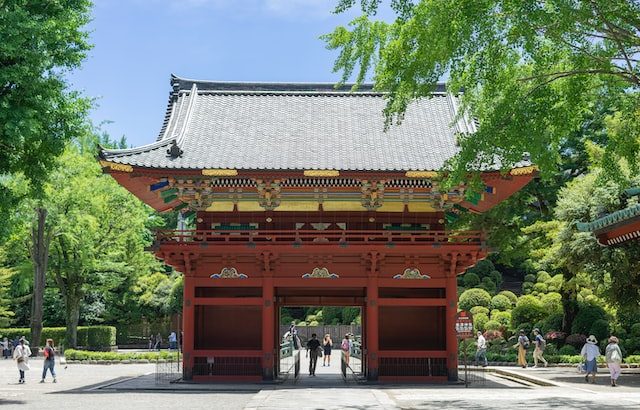One of the most remarkable things about Tokyo is how it seems to have seamlessly blended the modern and the traditional aspects of Japanese culture. However, it is a fact that the Japanese capital is a remarkable concrete jungle. Oftentimes, the towering skyscrapers, incredible displays of technology, and amazing city views overshadow its more serene historic neighborhoods. If you ever need to take a step back from the hustle and bustle of Tokyo, head over to the Bunkyo Ward and pay a visit to the beautiful Nezu Shrine.
With a history that dates back to the Edo Period, it is one of the oldest places of worship in the city. If you’re interested in Edo-style architecture, the shrine’s structure is a remarkable reflection of that. What makes it even more impressive is its hill of azaleas which reveal their bold colors in the spring— making it the ground zero for the Tsutsuji Matsuri. Known for its well-preserved buildings, many parts of its structures are designated as Important Cultural Properties.
A little background
Built in 1705, Nezu Shrine is one of Tokyo’s oldest Shinto shrines. Famous for the Bunkyo Azalea Spring Festival or Tsutsuji Matsuri when its hill of azaleas goes into bloom. Showcasing 50 species of the beautiful flower, it’s a sight to behold from late April to May. During the festival, a variety of games are played. In addition, the area near the shrine transforms as food stalls serving scrumptious Japanese street food are set up for the gathering crowd.
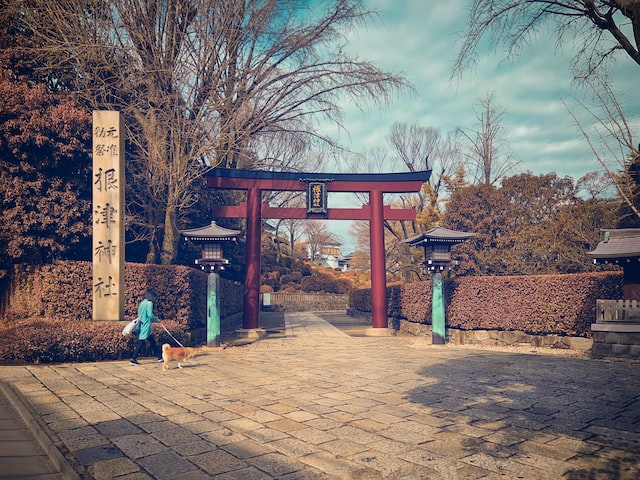
Another notable thing about the shrine is how it resembles one of the most famous shrines in Kyoto— Fushimi Inari Taisha. This is mainly thanks to the rows of vermillion-colored torii lining the walkway leading to the shrine— a feature that the Kyoto shrine is widely famous for.
Interestingly, it is one of the very few shrines in the capital that has remained preserved to this day. Despite the heavy bombardment in Tokyo during the Second World War, Nezu Shrine was miraculously spared. As such, its original structures have been successfully preserved to this day. As such, it is designated as one of the capital’s most important cultural assets.
History of Nezu Shrine
According to legends, the construction of the Shrine in the Sendagi area dates back two thousand years ago. Initiated by the hero prince Yamato Takeru, it is said to have been built to honor the Susanoo god. It was around 1705-1706 when the shrine was moved. By the orders of shogun Tsunayoshi, Nezu Shrine was relocated to its current and final location near Ueno Park.
It was also during this time when many of the buildings of the shrine were renovated. Additional structures were also built during this time, which leads to how it currently looks now. Where many shrines and temples across the country have suffered partial or complete destruction because of wars and fires, Nezu Shrine survived. Even more impressive is the fact that it remained unscathed when the rest of Tokyo almost got obliterated by World War II bombings.
Nezu Shrine holds the very rare distinction of being one of the oldest shrines in the city. It was also designated as one of the top ten shrines in the capital by the then Emperor Meiji in 1868. As such, many of its structures were identified as among Japan’s Important Cultural Properties.
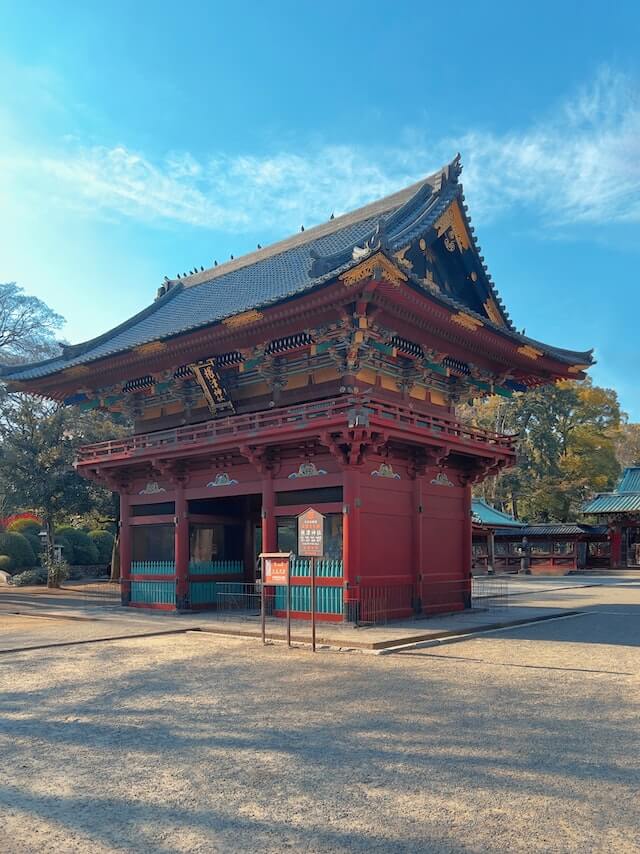
Fushimi Inari’s doppelganger
One of the most notable features of Nezu Shrine is its tunnel of red torii gates. Known as Senbon Torii, it is very much the same as the very famous Fushimi Inari Shrine in Kyoto. While the shrine itself may not be as grand as the one in Kyoto, it exudes a unique and serene charm. The pathway lined with vermillion torii gates is stunning as it creates an impression of stepping inside a tunnel.
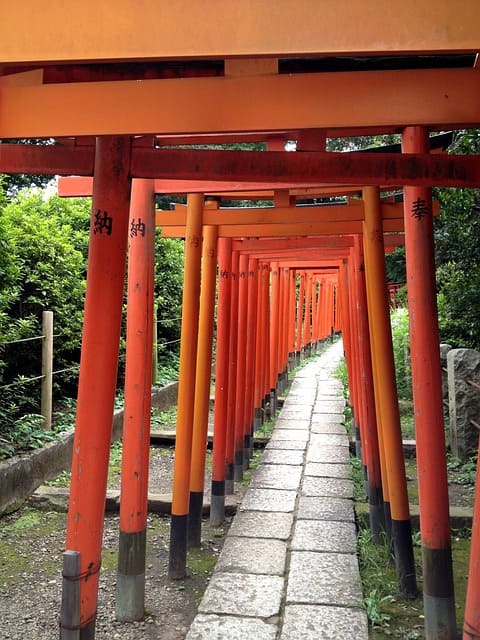
Walking along the path you’ll see an elevated stage known as the Otome Inari. Here, you’ll see a small shrine deifying the god of harvest. At the end of the pathway, you will see the Komagome Inari. The building, which is dedicated to a guardian deity, has been around long before the shrine was even relocated here.
Aside from the torii path, Nezu Shrine also features a pond that is home to vibrant koi fish. Then there’s its famous hillside garden of beautiful azaleas. The garden is perfect for taking pictures. Even more so, if you get the chance to visit here when the Bunkyo Azalea Festival is taking place. The hillside is transformed into wonder colors of purple, white, and red as the more than 3,000 azaleas go into full bloom.
Design inspiration
Nezu Shrine’s design is heavily inspired by the Nikko Toshogu Shrine which is situated in Tochigi Prefecture. This particular Shinto architecture style is known as ishinoma-zukuri or Gongen. This is especially notable in the way both shrines showcase highly elaborate gilded details. In addition, both shrines are also notable for their very colorful motifs— among the first things you’ll notice when seeing the shrine up close.
What’s great about Nezu Shrine is how it gives you a glimpse of what ancient Japan was like. The only difference is that you need not travel far to do so. After all, it is located right at the heart of Tokyo. It’s one of the best examples of how well Tokyo has blended the modern and the traditional. A visit to the Nikko Toshogu Shrine would usually only mean seeing shrines, temples, and of course, its scenic nature scene. Meanwhile, going to Nezu Shrine means you can easily make your way to Akihabara for some shopping. If you’re up for a night out after, you can easily head to one of the izakaya in Shinjuku.
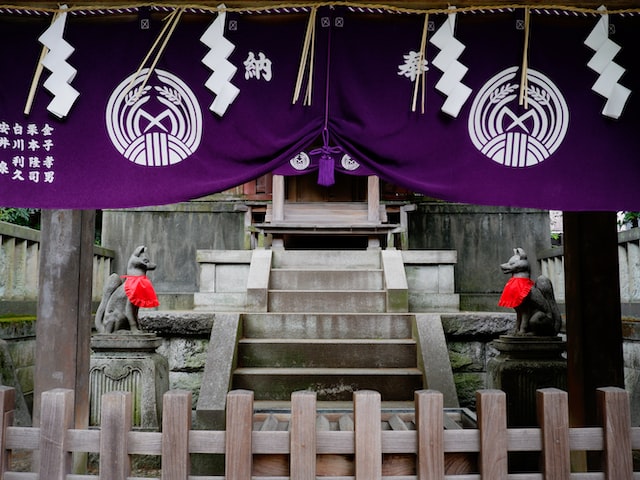
Notable features
Nearly every single structure of the Nezu Shrine has earned the designation of being Important Cultural Properties of the country. This is mainly due to how they have been built or rebuilt in 1706 and have remained preserved since.
Aside from its senbon torii, one notable feature of the shrine is the Romon Gate. Built in 1706, this two-storied gate still stands in modern times. A designated important cultural property, it is the only Romon Gate from the Edo period that has survived today.
Another important cultural property is the Karamon gate, which serves as the entrance to the shrine’s Shaden. Another important cultural property is the Nishimon gate, which is part of the walls that surround the Shaden. Made in the Munamon style, it is one of the few remaining gates of the style in Japan. This is because many other similar gates across the country have been destroyed due to natural disasters.

Bunkyo Azalea Festival/Tsutsuji Matsuri

Nezu Shrine is host to the Tsutsuji Matsuri or Bunkyo Azalea festival. Happening every April, it is named after the ward where the shrine is located. Vivid azaleas explode in white, pink and red during this time. It is a spectacular scene to witness in spring. With more than 3,000 plants in bloom, it is one scene you would want to witness if you’re visiting Tokyo around this time.
The garden features a wide variety of azaleas, which allows for a longer viewing period. This is also a great time to check out the many shops that are put up in the area. Aside from selling street food, many shops also sell toys, clothing, and handicrafts— perfect when you’re souvenir shopping. Traditional dance and song entertainment are also featured in the festivities. During the festival, the azalea gardens will be open to the public. A small entry fee is required for access.
A remnant of ancient Japan in modern Tokyo
If you’d love to experience traditional Japan but are pressed for time to go on a trip to Kyoto, you don’t need to go far. Steeped in history and impressively preserved since the Edo period, Nezu Shrine is truly a gem amid modernity. With its stunning architecture, beautiful azalea garden, and awe-inspiring senbon torii, who knew you can experience all that in Tokyo?
